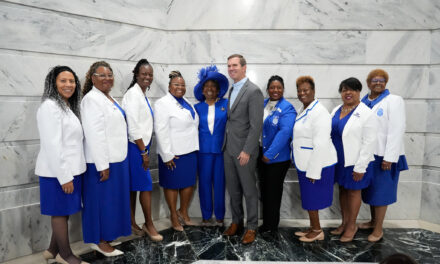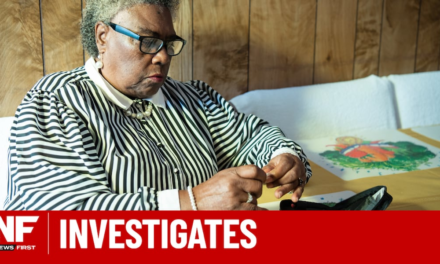
While I was researching my book on the Great Depression, the stories of hundreds of extraordinary people shone through. William Smith, the Lima farmer in his overalls, who talked back to fascist leader Virgil Effinger even though he was surrounded by hundreds of armed men with flashlights. Ruby Lucas, who sat on the stoop in her squirrel coat with a cup of coffee and announced: “I’m warring on the millionaire bankers whose greed has turned widows and orphans and destitute into slaves.”
Article continues after advertisement
Mary Hart, camped out in a white chair at city hall, who told reporters: “What they been payin ain’t enough for carfare.” The unnamed elderly man on horseback who, as he crossed the border, threw his hat up in the air and shouted “Viva Mexico!”
All of them, along with the inspiring collective actions of which they were part, have seemingly disappeared from history. So, too, the more chilling figures here: The men who held the flashlights. The policemen who threw down their badges and guns when told they could only use sticks, not bullets, against African American relief protesters.
Indeed, a common theme emerges in these chapters: invisibility. Women’s domestic labor was invisible to both their menfolk and to the state. The expulsion of a million Mexicans and Mexican Americans was invisible to most non-Mexicans and remains so. And then there was the Black Legion, trying to hide its clandestine work of hate. (The Ku Klux Klan, after all, was known as the “Invisible Empire.”)
Today, in most mainstream renditions of the Great Depression in the United States, these stories from the grass roots remain largely invisible, largely “forgotten.”
Article continues after advertisement We need their stories, though, for our own time, full of its own terrors—resurgent fascism, steel borders, climate change.
We need their stories, though, for our own time, full of its own terrors—resurgent fascism, steel borders, climate change. Neither capitalism nor racism has collapsed; patriarchy hums along.
Today, we need our own New Deal, too, an activist state that curbs the rich, defends labor rights, redistributes wealth, and provides a safety net and free health care for everyone. We can join those who advocate for a “Green New Deal” to help stave off climate disaster.
Trying to use the state to contain capitalism won’t ever be enough, though, because in its very nature the system dedicates itself to slipping out of, and tearing apart, any fetters. We need, like those seeking social justice in the 1930s, to dream of our own new social order, to build social movements that demand it, and to model it in our own collective lives.
During the time I wrote this book, three scary plagues visited my community. The first, of course, was the COVID pandemic. The second was a set of fires in August 2020 that destroyed over seven hundred homes in the Santa Cruz area, including those of people I knew, burned down acres and acres of beloved forests, and crept close enough to my house that the evacuation line was eight blocks away. For another year we prayed for rain, but instead got more drought.
In the last months before I finished this book, drenching rain was finally predicted for the day after Christmas. So I hurriedly planted grass where gophers had torn up the more-or-less lawn covering my backyard and had left bare dirt that turned into gunk that I tracked constantly into the house. I raked the soil, sowed grass seeds, covered them with mulch, then over it all spread burlap coffee sacks to protect the seeds from the birds, anchoring down the corners with bricks.
Article continues after advertisement
Then it rained, in biblical proportions, for days and days. Plague Number Three. Sinkholes four blocks from my house appeared on the national news, as did a levee breach in a nearby town that destroyed the homes and livelihoods of hundreds of already-impoverished people.
Less disastrously, my own backyard turned into a lake, which inched into my study and garage. It was only one inch deep; no historical research was hurt! But the seeds were underwater.
For three weeks I watched the lake drown them. When the lake finally receded, I lifted off the burlap, sadly. The seeds were still there—sparrows, juncos, and towhees arrived every morning to peck away at them. But no grass.
In taking on the terrors of our own time, we can take warning from those who served the powers of darkness during the Great Depression.
One morning, though, I detected individual, thin, dark blades miraculously scattered across the ex-lake. Then it flooded again, for another entire week. Now I mourned my drowned grasslings, which I imagined waving for help underwater, kelp-like in the murky swamp.
Finally, the waters sank for good. With a bit of sun, the grass babies flourished, their roots happy in the rich muck, locking in with each other in spreading horizontal networks that joined other, thicker patches on nearby higher ground. I looked out the window and saw a beautiful sea of green fur.
Article continues after advertisement
We are not grass. But we know how to survive fire and flood and beasts that tear up our landscapes. We know how to lay low, then rise up. We know how to survive when we are underwater. We know how to link our roots with others. We know our roots can flourish in deep muck. We know how to thrive.
And we know how to learn from history. William Smith, Ruby Lucas, Mary Hart, and the man on horseback didn’t, in fact, disappear. They all appeared in newspapers at the time, which is where I found them, and they are now in this book almost a hundred years later, speaking to us. They aren’t invisible.
In taking on the terrors of our own time, we can take warning from those who served the powers of darkness during the Great Depression. Most importantly, we can learn from the grassroots activists of the time who sought justice and equality, and carry them in our hearts as we step off our stoops, step over borders, and march into the streets, sinking our toes deep into the rich, messy muck of history.
______________________________

Article continues after advertisement
Excerpted from What Can We Learn from the Great Depression? Stories of Ordinary People & Collective Action in Hard Times by Dana Frank (Beacon Press, 2024). Reprinted with permission from Beacon Press.




